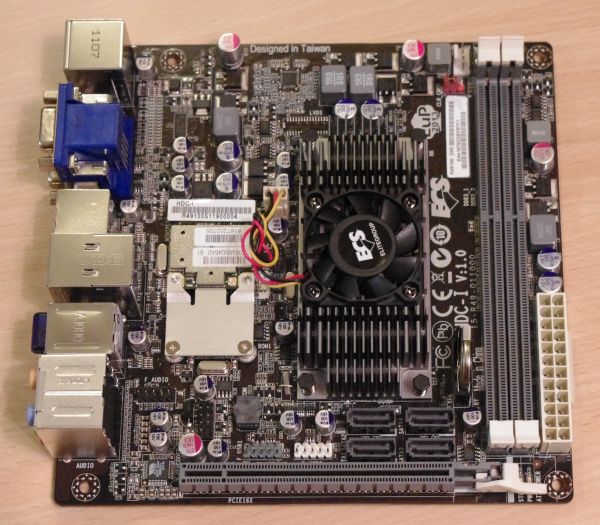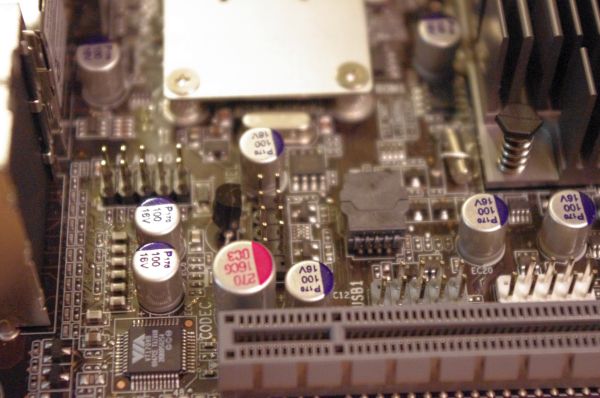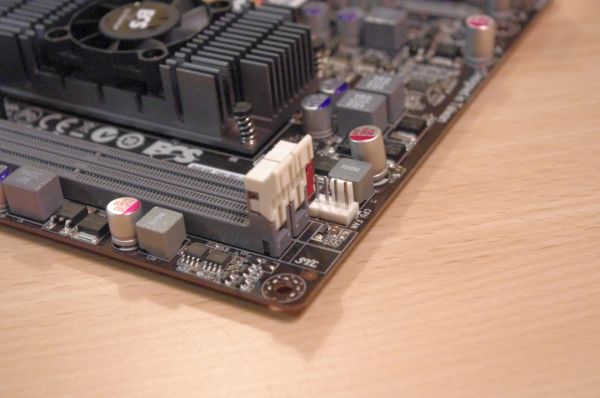Fusion E-350 Review: ASUS E35M1-I Deluxe, ECS HDC-I and Zotac FUSION350-A-E
by Ian Cutress on July 14, 2011 11:00 AM ESTAfter using the HDC-I, and running it through our bench suite, I was presently surprised. It has one awesome feature that other products don't have - a BIOS option that applies an automatic 33% overclock. So instead of having a dual core 1.6 GHz, we've got two cores at 2.13 GHz, which actually makes a lot of difference. There are some design flaws though, such as the position of the front panel headers, there's nothing to hold the wifi aerial, and I had some issues playing HD video smoothly. This board is a combination of adequate, with one particularly awesome feature.
Visual Inspection
With this mini-ITX board, as we've got active cooling on the heatsink, the heatsink is small compared to the ASUS beforehand. This should, theoretically, give more space for other additional bells and whistles on the board. However, aside from the front panel and the audio headers, there are only two USB headers. These are all on the bottom left of the board, potentially making them awkward in a case.
The Front Panel audio could be especially tricky to deal with, depending on the case or and PCIe card you are using. The PCIe slot can support a 16x card, but will only run at 4x speeds, like the ASUS, which leads to disappointing results later in the gaming test suites when I overpower this board with a GTX 580.
The SATA ports are in the corner of the DIMM and PCIe slots - here we have four SATA 6 Gbps all native to the chipset. Beside this in the corner is a couple of lights - one to confirm power to the board and another to confirm the board has been switched on. In terms of fan headers, there is one at the top of the board, next to the clear CMOS header, but no others.
The I/O panel is one of the more feature rich of the ones being reviewed today, but that is in part to using active cooling (which on the ASUS board takes up the equivalent of a DVI slot) and that there's nowhere to set the wifi antenna in to. Nevertheless, there are HDMI, DVI and VGA outputs on the rear, Ethernet, Bluetooth, optical S/PDIF out, audio input/outputs, six USB 2.0 ports, two USB 3.0 ports and an eSATA 6 Gbps port.




















67 Comments
View All Comments
ET - Saturday, July 16, 2011 - link
Here are a few links to E-350 reviews using a desktop PSU. Not a comprehensive list by any means:http://www.guru3d.com/article/amd-brazos-platform-...
http://www.overclockersclub.com/reviews/sapphire_f...
http://www.xbitlabs.com/articles/mainboards/displa...
http://www.eteknix.com/motherboards/jetway-nc85-e3...
http://www.tweaktown.com/reviews/4093/asus_e35m1_i...
And of course Anandtech's first review of the platform:
http://www.anandtech.com/show/4134/the-brazos-revi...
ET - Friday, July 15, 2011 - link
In the conclusion you say about the ECS: "Having 33% free of anything is usually a good idea, so when it comes part of the package with very little increase in power consumption, it is a good thing. As a result, all the benchmarks and all the games had much, much higher scores than the other boards we tested."Unfortunately these gaming performance figures don't appear in the article. This looks like an oversight that needs to be corrected.
Mitalca - Friday, July 15, 2011 - link
I second that.Through the review there's a lot of times when Ian talks about the marvell the ECS did with the 33% OC. Then why you didn't show the results?
One of the bigest flaws in this review, that make a lot of people suspect of a way-too-much-biased review.
Testing with a 580 is ridiculous, even if you want to "provide a plausible maximum ceiling". I spend $500 and I only get 50% more frames. What about a U$ 50-100 gpu?? If the CPU and the memory are by far the bottleneck, we should see similar results.
And, once you show the huge benefits that overclocking does to the iGPU, why not try it with the dGPU?
ET - Saturday, July 16, 2011 - link
The main thing I would like to see added to the discrete GPU test is an AMD GPU. The CPU usage of NVIDIA and AMD drivers are different, so results may be different.I don't think that a discrete GPU is worth using with the E-350 in any case, and the test with the GeForce 580 pretty much proved that. It's just too CPU limited.
xorbit - Friday, July 15, 2011 - link
This review is a steaming pile. At least it lends credibility that Anandtech might not be biased, just woefully incompetent.An HTPC review without HTPC benchmarks and coupling the chips with impropper PSU/GPUs.
silverblue - Friday, July 15, 2011 - link
Without wanting to start a huge squabble, if you guys think you could do better...lestr - Friday, July 15, 2011 - link
Tom's already did: Daily Hardware 7/6. 8 boards with more relevant tests though somewhat incomplete.My big question is: WHAT is AMD afraid of? SUCCESS? AMD fanboy but when they could really kick a** they give us another "almost".
Another question: Does the PCIe slot support anything other than graphics? Can I stuff a Hauppauge 2250 or a Ceton card in it? This is totally ignored on almost ALL current ITX boards. You're about as likely to win the Kentucky Derby with a 3-legged horse as playing any games on this platform. What's the point?
The E450 (1.65 / 1333 / HD 6320) is due out any time. Standards on this platform should include 6 audio outs (hello Asus!), mPCIe, fp USB3.. how about DUAL channel memory? What's a few more watts anyway? Is 35W APU too many? RAID?
I wish AMD would pull out all the stops and do this little thing right.. entice the partners as well. If they can't do anything else but bury Atom/NV ... AMD needs to win something sometime.. why not NOW?
Any comments, Ian?
mino - Friday, July 15, 2011 - link
Brazos is sigle channle.There are 35W Llano E2 series APU's on the way.
Brazos is SOLD OUT for 3 quarters allready ... talk about AMD being afraid ...
medi01 - Sunday, July 17, 2011 - link
Idiot detected.Wander7 - Friday, July 15, 2011 - link
Just by looking at the two heatsinks and not doing any measurements, it looks like the Asus' heatsink is suffering from air stagnation because the fins are too close together....